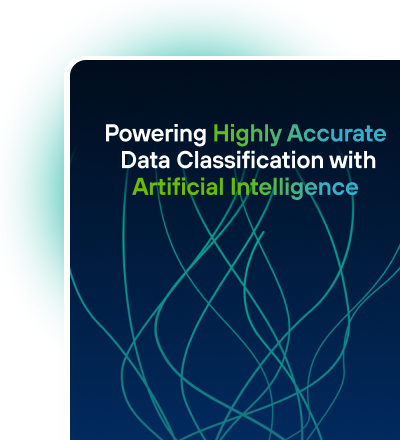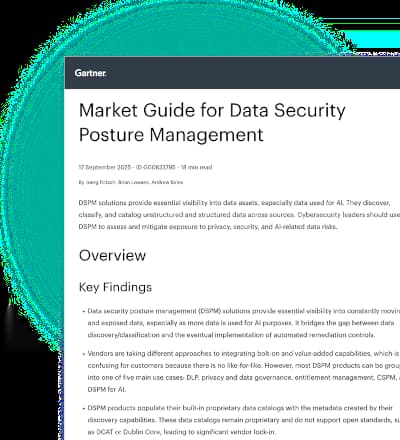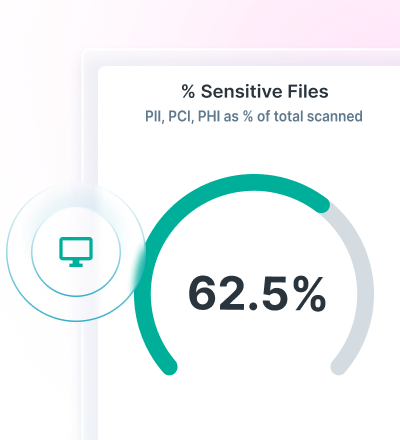1.2万社以上のお客様に利用されています










































超高速でエンタープライズ全体のデータを検出し、カタログ化します。
Forcepoint Data Classificationは、AI Meshを使用して、高精度なデータ分類を実現します。 ネットワーク型AIアーキテクチャは、小規模言語モデルと高度なAIコンポーネントに依存し、効率を向上させ、誤検出を軽減します。


Gartner®: Market Guide for Data Security Posture Management
In their first analysis of the new DSPM security category, Gartner® identifies the five main use cases, breaks down DSPM features and explores the requirements for securing GenAI.
Forcepoint Data Classificationを選ぶ理由とは?
複数のソースにわたってデータを分類し、AI Meshを使用して精度と効率を継続的に改善し、組織の貴重な時間とリソースを節約します。
業界で最も広範なデータタイプをカバーすることで、コンプライアンスが簡素化され、組織のデータに対するより良い保護が実現します。
AI Meshはミリ秒単位でデータを迅速かつ正確に分類し、プロセスを効率化し、手動作業を削減し、チームはより価値の高いタスクやより重要なインシデントに集中できます。
主要な規制と、業界で最も広範なデータタイプのカバレッジにより、コンプライアンス違反による高額な罰金を回避します。

Data Security Everywhere Forcepointでデータをあらゆる場所で保護します。
データセキュリティソリューションで、侵害を防止し、コンプライアンスを簡素化し、ポリシー管理を統合し、リアルタイムでリスクに適応します。
Forcepoint DLP: DLPのSoftware-as-a-Service(SaaS)で機密情報を保護し、コンプライアンスを強化します。
DSPM(Data Security Posture Management):データ検出、分類、オーケストレーションを自動化し、企業全体でデータを完全に制御し、可視化します。
Risk-Adaptive Protection:ユーザーの行動に基づいてポリシーを自動的に調整し、新たなリスクにリアルタイムで適応します。
よくある質問
Data Classificationとは?
Data Classificationは、データを事前定義のカテゴリにタグ付けし、整理する手法であり、データ検出と検索を容易にし、権限のあるユーザーに安全なアクセスを適用します。
Data Classificationが組織にとって重要な理由とは?
Data Classificationの実践は、強力なセキュリティ体制を維持するために必要です。セキュリティチームが機密情報の検索場所を把握していることを保証し、データへのアクセスを許可するユーザーに関するルールを導入することで、データ侵害を防止または抑制し、不正なユーザーを本来持つべきでないリソースから保護します。
Data Classificationのタイプとは?
コンテンツベースの分類:これはファイルを検査し、その中の機密情報を検索する手法です。 これは、一見無害なファイルタイプに隠れている公衆消費向けではない情報に関する問題がある場合に役立ちます。
コンテキストベースの分類:このアプローチは、ファイルコンテンツを直接検査する代わりに、主にファイルに関連付けられているメタデータを調べ、内部のデータが機密であるという手がかりを検出します。 これには、ファイルが保存されている場所、ファイルが作成されているユーザー、またはファイルが構築されているアプリケーションの特定が含まれます。 このアプローチは、ユーザーベースが十分にトレーニングを受け、機密データをすでに一定程度制御している場合に適しています。
ユーザーベースの分類:これにより、ユーザーはファイルを調べて分類する負担を負います。 このアプローチは、最善の場合、誤検知を大幅に減らすことができますが、高度なトレーニングを受けたユーザーベースだけでなく、データを手動で分類する必要があります。つまり、通常は簡素化された組織や小規模なデータセットにのみ適しています。
Data Classificationを導入するためのベストプラクティスとは?
識別:クラウドリポジトリや物理ハードドライブなど、機密データがどこに存在しているかを検出し、暗号化、物理アクセス制御などを使用してデータを保護するために必要な手順を即座に講じます。
組織:データをカテゴリに編成するために使用するプロセスを考え出します。
トレーニング:従業員がデータをタグ付けし、カテゴリに基づいて適切な場所に配置する役割を担うようにします。 プロセスで役割を持つ人が多いほど、ヒューマンエラーが努力を損なわないようにするためのトレーニングが厳格になります。
コンプライアンス:業務に適用されるデータセキュリティとデータプライバシー規制と、コンプライアンス違反の罰則を理解します。ソリュー
ション:組織に最適なData Classificationソリューションを見つける。多くの場合、さまざまなベンダーの異なるソリューションを組み合わせてパッチを適用するよりも、データ検出、分類、優先順位付けを支援する総合的なデータセキュリティプラットフォームを使用するのが最善の方法です。
Data Classificationは規制コンプライアンスに役立ちますか?
はい。Forcepoint Data Classificationは、80以上の地域でコンプライアンスを簡素化します。 主要な規制と、業界で最も広範なデータタイプのカバレッジにより、コンプライアンス違反による高額な罰金を回避します。
Forcepoint Data Classificationの精度は?
Forcepoint Data Classificationは、AIを活用した精度と効率を提供します。AI Meshテクノロジーを使用して、複数のソースにわたってデータを分類し、精度と効率を継続的に改善し、組織の貴重な時間とリソースを節約します。
AI Meshとは?また、その使用方法は?
Forcepoint Data Classificationは、AI Meshを使用して、高精度なデータ分類を実現します。 ネットワーク型AIアーキテクチャは、小規模言語モデルと高度なAIコンポーネントに依存し、効率を向上させ、誤検出を軽減します。











